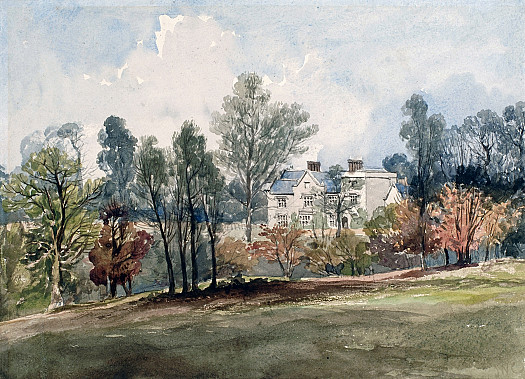John Wilson Carmichael was born at Ouseburn, Newcastle upon Tyne, on 9 June 1799, the eldest of the three children of the shipwright, William Carmichael, and his wife, Mary (née Johnson), the daughter of a mariner. During his teens, he spent three years at sea, working on a ship that sailed between Spanish and Portuguese ports. He then followed his father’s trade, and was apprenticed to the ship builder, Richard Farrington & Brothers, of North Shore, Newcastle. The Farringtons were also cabinet makers, upholsterers, gilders and carvers, and were engaged in the cultural life of the town.
As a result, they recognised and encouraged Carmichael’s artistic talent, Joseph Farrington buying him his first box of watercolours. In time, he also became a friend and pupil – however informally – of Thomas Miles Richardson Senior, the leading artist in Newcastle at the time. From the early 1820s, he collaborated closely with the architect and developer of Newcastle, John Dobson, working up his perspective drawings into arresting watercolours, complete with figures.
In 1825, Carmichael stopped working as a carpenter, and set himself up as a landscape painter and drawing master. In the following year, he married Mary Sweet in Ryton, a little west of Newcastle, and they settled at New Road, in Newcastle itself. (By 1846, they had eight children.) His later residential and studio addresses in Newcastle comprise Blackett Street, Percy Street, Grainger Street, and Hood Street.
In 1827, Carmichael was, with T M Richardson and Henry Perlee Parker, instrumental in founding the Northern Academy of Arts, and it would become the main local showcase for his work. His increasing abilities as a painter and illustrator of landscapes and marines soon attracted influential local patrons, both private and civic, including Major George Anderson and Trinity House, Newcastle (a charitable guild of seafarers). With the arrival of George Balmer in North Shields in 1831, Carmichael gained a friendly rival and, eventually, intimate friend, and they would collaborate on several paintings. His interest in developing infrastructure led, among other projects, to a further collaboration, that with John Blackmore on the the illustrated book, Views on the Newcastle and Carlisle Railway (1836).
From 1835, Carmichael exhibited in London, at the Royal Academy of Arts (21 works, 1835-59) and the Society of British Artists (6 works, 1838-47). Successes at these venues led him to move to the capital a decade later in 1846, and he and his family settled at 20 Howland Street, Bloomsbury. In 1853, they moved to 8 Milton Street (now Balcombe Street), Marylebone. Carmichael continued to work hard and ambitiously, producing large-scale historical and contemporary subjects, which he exhibited at the British Institution (21 works, 1846-62) as well as the Royal Academy.
In 1855, The Illustrated London News commissioned him to go to the Baltic to record the events of the Åland War, a naval conflict between Russia and the allied nations of Britain and France, which related to the Crimean War. The trip resulted not only in the drawings that were engraved for publication in The Illustrated London News but also several paintings. The Baltic was probably the furthest extent of his travels during his years as an artist, and his Mediterranean subjects are likely to have been based on sketches by others. His abilities as a technician were exploited by Winsor and Newton when it commissioned him to produce two handbooks: The Art of Marine Painting in Watercolours (1859) and The Art of Marine Painting in Oil Colours (1864).
Following the death of a son in 1862, Carmichael left London and settled at 18 Mulgrave Terrace, Scarborough. He continued to paint, and produced a number of watercolours of the northeast coast. Dying in Scarborough on 2 May 1868, he was survived by his wife and most of his children. His studio sale was held at Christie, Manson & Woods, in London, on 24-25 November 1870.
Carmichael’s eldest daughter, Margaret, was the mother of the artist, Herbert Gustave Schmalz.
Another daughter, Annie, married the wood-engraver, William Luson Thomas, who founded the illustrated weekly newspaper, The Graphic, in 1869, as a rival to The Illustrated London News.
His work is represented in numerous public collections, including the National Maritime Museum (Greenwich) and the V&A; and Brighton and Hove Museums and Art Galleries, Grimsby Fishing Heritage Centre, Hartlepool Museums and Heritage Service, Laing Art Gallery (Newcastle), Shipley Art Gallery (Gateshead), Sunderland Museum & Winter Gardens and York Art Gallery.
Further reading:
Andrew Greg, ‘Carmichael, John Wilson (1799-1868)’, H C G Matthew and Brian Harrison (eds), Oxford Dictionary of National Biography, Oxford University Press, 2004, https://doi.org/10.1093/ref:odnb/4703;
Andrew Greg, John Wilson Carmichael: Painter of Life on Sea and Land, Tyne and Wear Museums, Newcastle upon Tyne, 1999;
Diana Villar, John Wilson Carmichael 1799-1868, Portsmouth: Carmichael and Sweet, 1995


